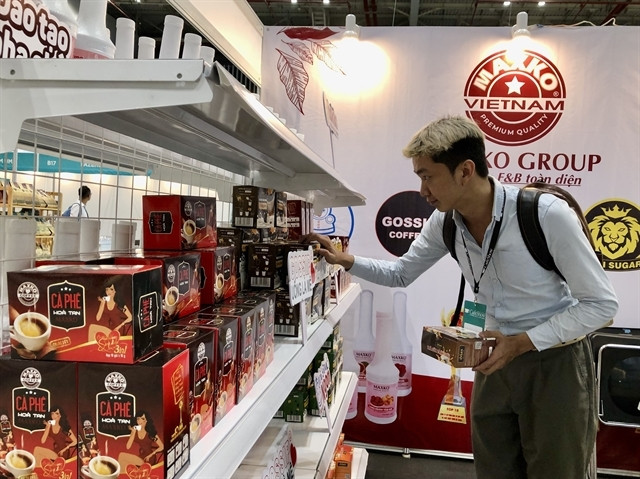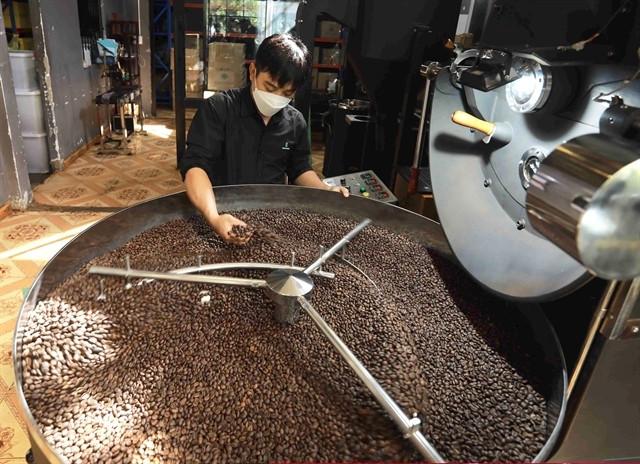 |
| DANCE OFF: A folk dance show at the World Coffee Museum in Buôn Ma Thuột City. VNA/VNS Photo Tuấn Anh |
The Vietnam Cafe Show just ended after two days full of activities, with impressive numbers: 30,000 visitors from 45 countries, and 300 exhibitors.
Starting in 2016, the show is a much-awaited event organised by Korea-based Cafe Show, and has built a common playground for people to know what's up and coming in the F&B industry. The Cafe Show in Hồ Chí Minh City is among a larger series of Cafe Shows in Seoul, Shanghai, and Paris.
Việt Nam is one of the world’s biggest Robusta producers and is the second-biggest coffee exporter worldwide. US-based Mordor Intelligence has projected the size of the Vietnamese coffee market at US$511.03 million in 2024 and up to $763.46 million in 2029 with a compound annual growth rate of 8.13 per cent
At the show, new flavours offered by baristas were welcomed by the younger generation. Khe Sanh Coffee from Quảng Trị Province, an area once associated with war, today offers some of the best coffee on the market.
Future foreseen: An avid coffee drinker during his life, President Hồ Chí Minh used to tell everyone he met that when peace finally came, international visitors should come to try Vietnamese coffee, some of the best in the world. Having worked for renowned chef Escoffier in London during his early years, Hồ Chí Minh turned down the chef's offer to be trained as a great chef but these tastes remained with him even during working trips, when basic food such as rice and a fried egg had to make do. He would sometimes showcase his skills to dazzle those accompanying him by decorating his fried eggs with black diamond shapes on top. Uncle Hồ had to work long hours well into the night, and developed a habit of smoking and drinking coffee from when he was young. After his morning work and before breakfast, he would have a strong cup of hot black coffee without sugar. He would have Robusta, which has more caffeine. When working late at night, he would take milk in his coffee.President Hồ Chí Minh could foresee the future of the coffee industry in Việt Nam, saying, Việt Nam had some of the best coffee in the world. Come and try it for yourself to decide.
 |
| GREAT LEADER: President Hồ Chí Minh checks out on coffee beans while on a visit to a plantation. File Photo |
Nguyễn Duy Phương, Chairman of the Bốn Phương Co-operative, has dozens of years of experience in the industry. He has been busy introducing a new coffee variety to the customers, jackfruit coffee, with honey-roasted coffee beans also being added to more traditional Robusta and Arabica beans.
Robusta
Coffee planted in Việt Nam has been exported to more than 70 countries and territories around the world. Being the second-biggest coffee exporter behind Brazil, Việt Nam only ranks sixth in coffee area. But its productivity is the greatest at 1.4 times higher than that of Brazil, 2.8 higher than Colombia, and 4.5 times higher than Indonesia.
Experts have forecast that Việt Nam’s coffee production in the 2023-2024 season could be reduced by 10 per cent to 1,656 million tonnes, the lowest in four years due to drought. The global Robusta reserve has been shaky, leading to market volatility amid fears of a shortage.
The Việt Nam Coffee and Cocoa Association (VICOFA) has announced that the quality of Vietnamese beans has dramatically been improved thanks to farmers changing their cultivating methods to VietGAP and organic practices. They also pushed more strongly towards producing speciality coffee and processed beans.
VICOFA has forecast that the bean price in the domestic market will stay high this season due to a severe supply shortage in the 2022-2023 season. It estimates there is still a lack of between 1.5 – 2.5 million coffee bags needed to fulfil signed contracts. Meanwhile, farmers still do not want to sell at current prices, which in turn pushes the price higher.
It also cites a reduction in coffee production this season due to drought. Climate change is also wreaking havoc on the cultivation practices of coffee farmers. They are increasing other crops, such as durian and other fruit with a high price.
According to a recent Reuters research, the Robusta price is expected to increase by 28 per cent by the year-end, while production will be slightly reduced. This shall push the price to go even higher.
Coffee expert Nguyễn Quang Bình forecasts that coffee prices this 2023-2024 season will stay high because it’s the time world's brewers stock up for the following year, keeping demand high.
But the ongoing drought does seem to have caused havoc on coffee plantations waiting to be harvested. Bình suggests that if this harvest is bad, then the price of agricultural produce shall be fixed again, despite all state agencies’ efforts to regulate prices.
If climate change leads to a lack of staple food in some countries, it could lead to civilian unrest, and higher consumer prices in the developed world will continue to lead to inflation and crisis in daily consumption prices.
 |
| INDUSTRY EVENT: The International Cafe Show Vietnam 2024 took place at the Saigon Exhibition and Convention Center in co-ordination with Exporium Việt Nam Ltd., Vietnam Coffee-Cocoa Association, Buôn Ma Thuột Coffee Association and other trade promotion agencies. VNA/VNS Photo Mỹ Phương |
Worrying scenario
In some coffee plantations in the Central Highlands and the Mekong Delta, some farmers rush to destroy coffee to replace it with durian.
The driving force for this massive coffee tree smashing was the MoU that Việt Nam recently signed to export durian to China.
Last year, durian exports grew by 480 per cent, bringing enormous gains for durian farmers, with coffee growers not wanting to be left behind.
According to the Ministry of Agriculture and Rural Development (MARD), the durian area has grown by 24 per cent year-on-year, which is the highest among all crops. Currently, the total area for durian is estimated at 110,000ha.
The country’s large strips of agricultural land such as the Central Highlands, the Mekong Delta, and east of the Southern delta all have a large durian cultivating area.
“Now other agricultural produce such as coffee and pepper can bring back between VNĐ200 – 300 million per hectare. But durian can bring farmers up to VNĐ2 billion, five times higher than growing coffee,” said Đỗ Hà Nam, VICOFA Vice President.
“It’s very hard to convince the farmers to stop cutting down coffee trees.”
According to MARD, the coffee area is now estimated at 700,000ha, but could even have been shrunk to 600,000.
This drive to alter crops due to a short-term rush for profit has been warned of by experts as it poses many risks.
The Ministry has sent out two warnings, alerting gardeners to seriously consider not cutting down mixed plantations to plant one crop only.
Đắk Lắk People’s Committee has also warned its farmers not to increase their durian and passion fruit area, as it will be unsuitable for climate and soil, and have irrigation difficulties.
The Robusta planting area reduction has led to the country’s Robusta exports decreasing by 21.3 per cent in 2023.
If this trend continues, then our country could lose its second-biggest coffee exporter status.
Nguyễn Như Cường, Head of the Planting Department at MARD, said that if the new durian area is located in salinated land or not irrigated properly, it could in turn reduce the quality of the durian and spoil the overall reputation of durian from Việt Nam.
 |
| FULL OF BEANS: Đắk Nông Province gradually built speciality coffee plantations according to the Specialty Coffee Association and Coffee Quality Institute. Pictured is the BaZan Coffee Company Ltd. in Gia Nghĩa City, Đắk Nông Province, which provides 60 tonnes of coffee products for the domestic market and export to Italy. VNA/VNS Photo Vũ Sinh |
Plan of action
Coffee has become the best-growing product in the first quarter of 2024. MARD announced that in the first three months, Việt Nam exported nearly 600,000 tonnes of coffee yielding $1.9 billion, an increase of 44.45 per cent in quantity and 54.2 per cent by value over 2023. Coffee exports made a historic milestone by nearly hitting $2 billion in only three months.
“The lack of coffee supply in the world has helped Vietnamese businesses to export. If the market continues its trends like now, coffee exports of Việt Nam in 2024 can smash the $5 billion mark,” Chairman Nguyễn Nam Hải of VICOFA said.
Việt Nam has also increased its export countries list to include Italy, Spain, Russia, Indonesia, Belgium, China, and the Philippines.
 |
| COFFEE ART: Among all the types of coffee, egg coffee has been a signature. Pictured here is the egg coffee Australian Foreign Minister Penny Wong had when she visited Ha Noi and strolled around Hoan Kiem Lake. Her cup of egg coffee had a Turtle Temple image. VNA/VNS Photo Lâm Khánh |
Export companies have said that Vietnamese coffee exports have built a respectable reputation in world markets. Despite the lack of supply, Vietnamese beans are still what international brewers are after. This fact, according to VICOFA Chairman Hải, provides an edge and a reputation to keep.
Exports experts agree that the coffee industry needs to be geared towards sustainable development, not letting the $5 billion mark be just a passing moment. Businesses need to encourage farmers to replant the coffee area lost to durian, as it took a long time to become the world's second-biggest coffee exporter with the best productivity. It’s an undeniable success, which should not be damaged by short-term profiteers. VNS